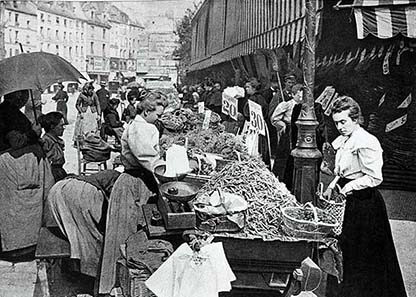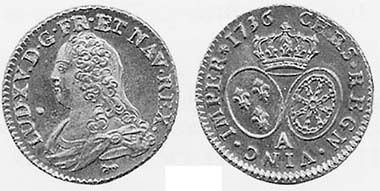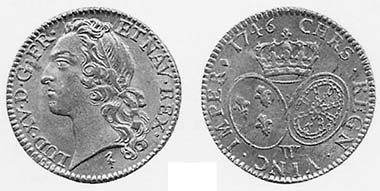Every day, thousands of tourists stroll about the Rue Mouffetard, the “food alley” of Paris. Amongst aromatic cheese and huge sides of beef very few are aware that that one of the most spectacular coin treasures of the 18th century was found in house no. 51-53.
The Rue Mouffetard market on a photograph from 1896.
When the building was pulled down in 1938, a hoard was found containing 3.210 Louis d’or plus 258 double and 87 half Louis d’or, all minted under Louis XV. So far so unspectacular, one might think. Hoard finds from Modern Times might be of interest to the circulation of money but they do not provide any new information to numismatics. That treasure, in contrast, was something special: some of the coins were wrapped in a last will!
The will’s writer was a person known to the archives, a man called Louis Nivelle who lived a decent life as an honoured citizen and worked as a court usher in the palace chancery. That was a considered and highly profitable position in those days. Things were quite different on the private level since Louis Nivelle was a Jansenist, i.e. a supporter of a sect founded by the Netherlander Cornelius Jansen (1585-1638).
Cornelius Jansen (1585-1638).
Jansen belonged to the Calvinist-Presbyterian movement. He propagated an internalisation of piety and rigid ethics amongst his followers. His arch enemies were the Jesuits which he accused of being slaves to the pope. The aim of the Jansenists was to weaken the papal central authority by a gain of power for the local bishops – of course, that plan could not be tolerated by the Catholic Church. Jansen’s teaching was condemned in two bulls, one called “Vineam domini“, issued in 1705, the other called “Unigenitus“ from 1713. Louis XIV (1643-1715), who was known inter alia for displacing the Huguenots, also persecuted the Jansenists. That did not change under his successor Louis XV (1715-1774).
In this climate of fear and suspicion Louis Nivelle stuck to his Presbyterian religion. But he began to live a double life. Apart from his town house in the rue de la Coutellerie he owned a small flat in the rue Mouffetard. He died in October 1757. The sole heir of his fortune was his daughter who, unfortunately, did not find the treasure her father has left her. It took nearly 300 years for the gold coins hidden out of fear in a house unknown to the family to see the daylight again.
Louis d’or “aux lunettes”. Paris 1736. From auction sale Bourgey, Paris, June 13th, 2005, 157.
The legal aspect of this find is interesting. Since that hoard find did not remain anonymous – a rarity – but was the legal property of Louis Nivelle’s heirs the state spotted 83 descendants of Louis Nivelle. The proceeds the sale of the 3.555 coins yielded was split amongst them.
Louis d’or. Lille 1746. From auction sale Bourgey, Paris, June 13th, 2005, 162.
All coins were sold with a certificate clearly stating the provenance for any future owner.
Keep in mind: if you think of hiding your treasure provide it with your name and your address. Your descendants in 300 years from now will be grateful that the private property will not be confiscated by the state but divided amongst your heirs.







